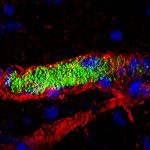Link to Pubmed [PMID] – 24747976
J Vis Exp 2014;(86)
Neisseria meningitidis causes a severe, frequently fatal sepsis when it enters the human blood stream. Infection leads to extensive damage of the blood vessels resulting in vascular leak, the development of purpuric rashes and eventual tissue necrosis. Studying the pathogenesis of this infection was previously limited by the human specificity of the bacteria, which makes in vivo models difficult. In this protocol, we describe a humanized model for this infection in which human skin, containing dermal microvessels, is grafted onto immunocompromised mice. These vessels anastomose with the mouse circulation while maintaining their human characteristics. Once introduced into this model, N. meningitidis adhere exclusively to the human vessels, resulting in extensive vascular damage, inflammation and in some cases the development of purpuric rash. This protocol describes the grafting, infection and evaluation steps of this model in the context of N. meningitidis infection. The technique may be applied to numerous human specific pathogens that infect the blood stream.

